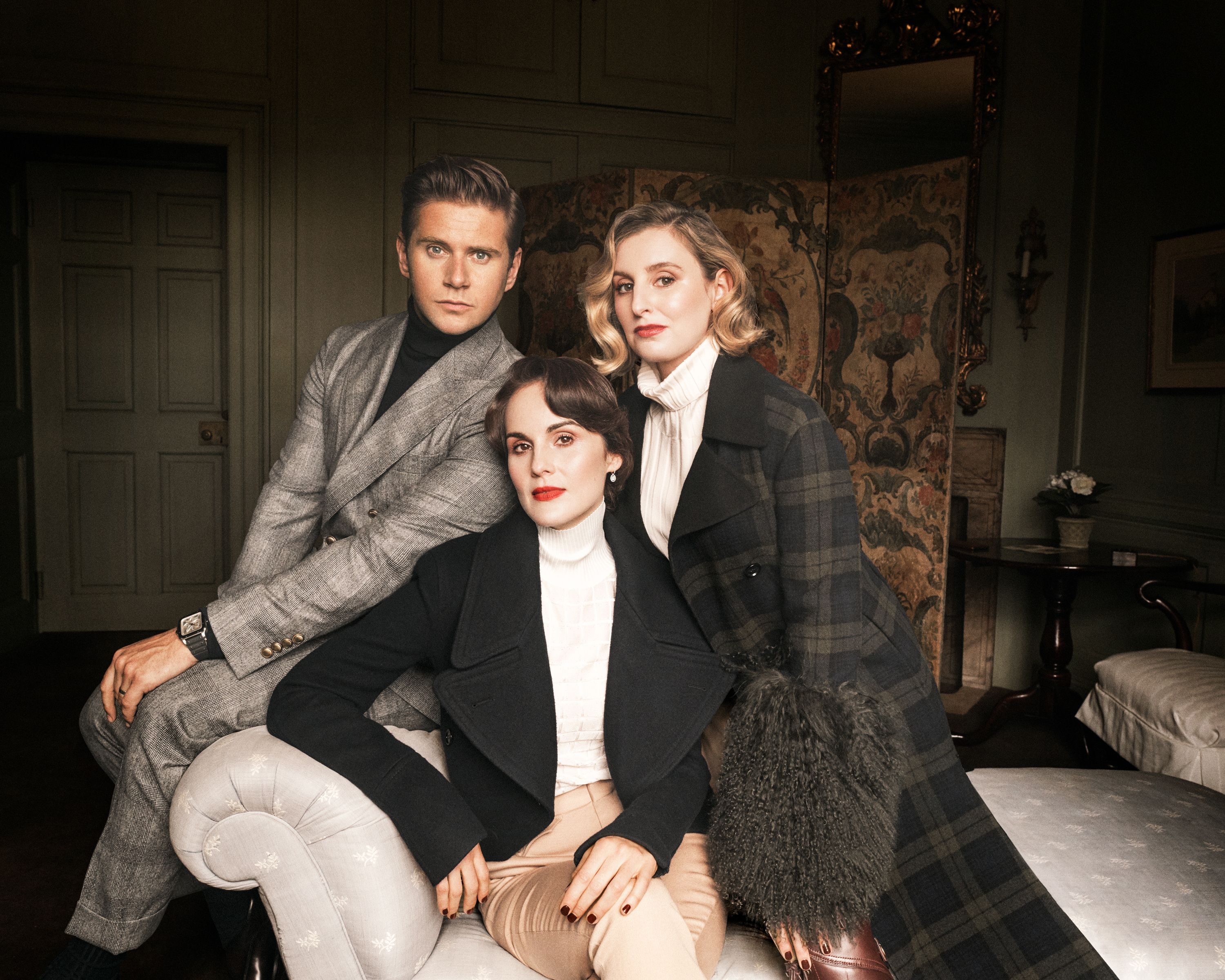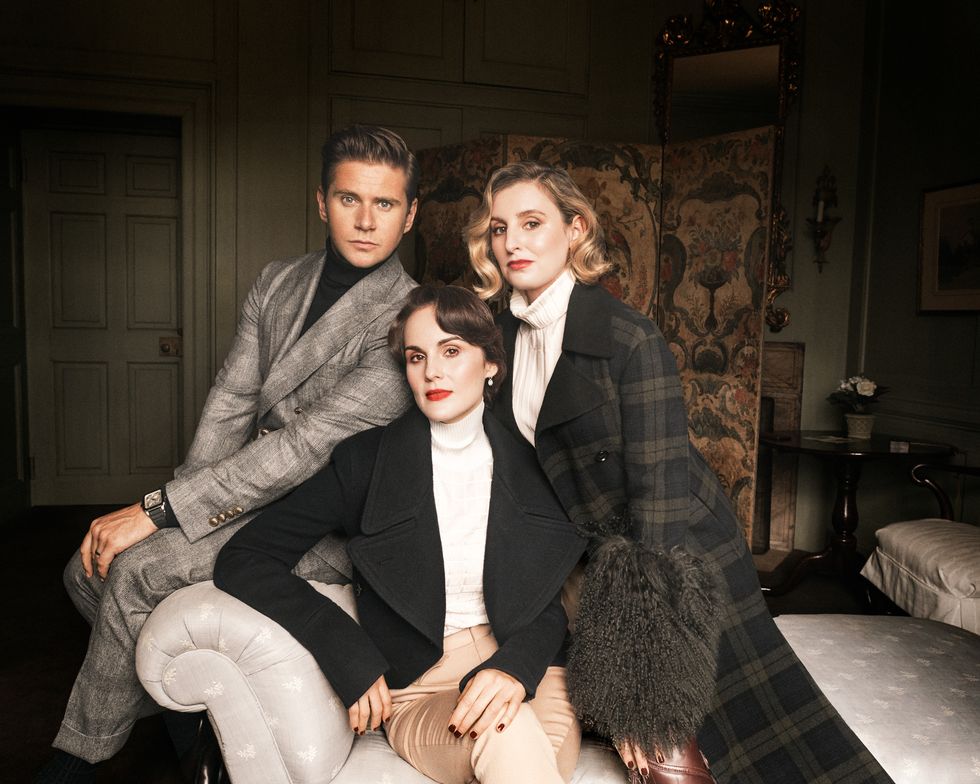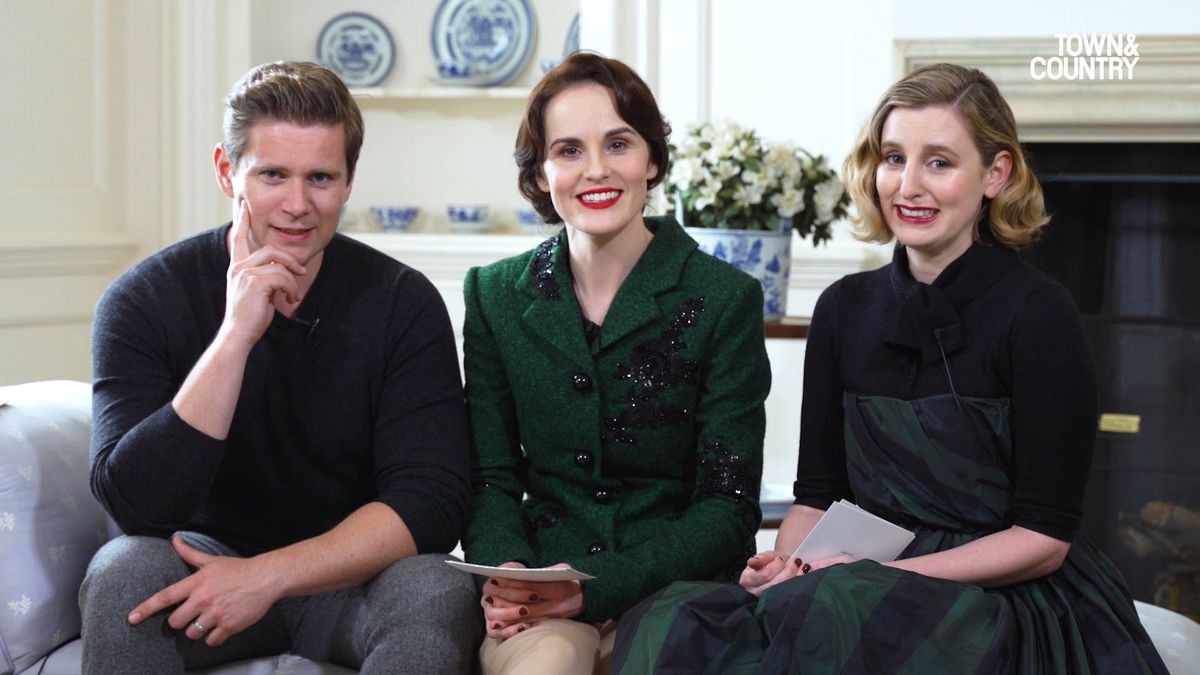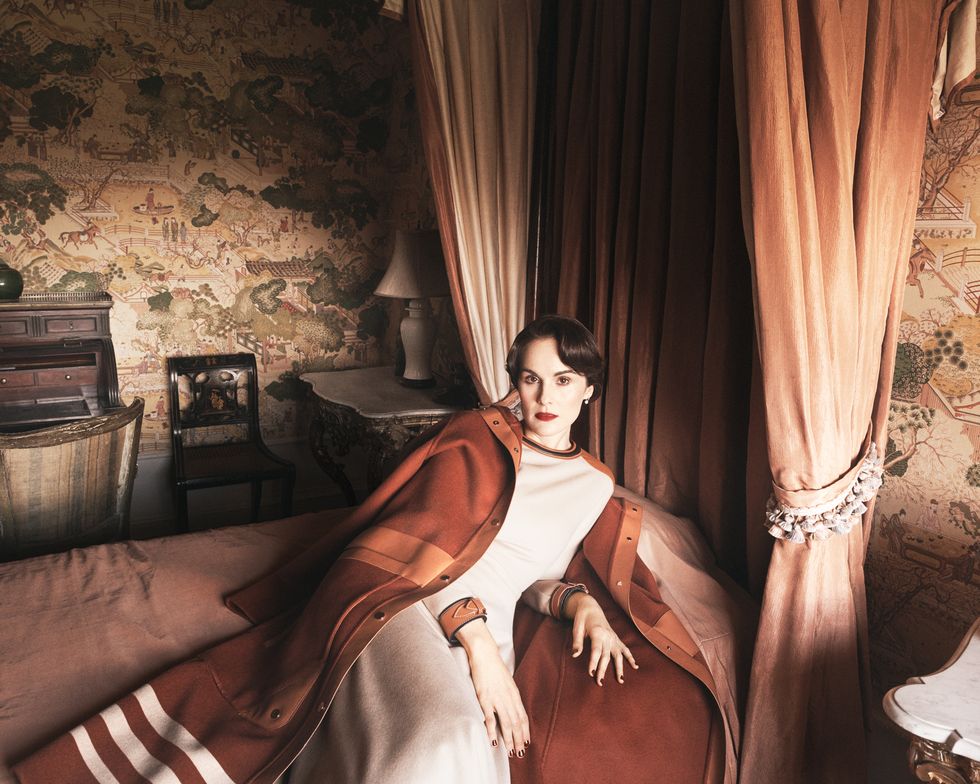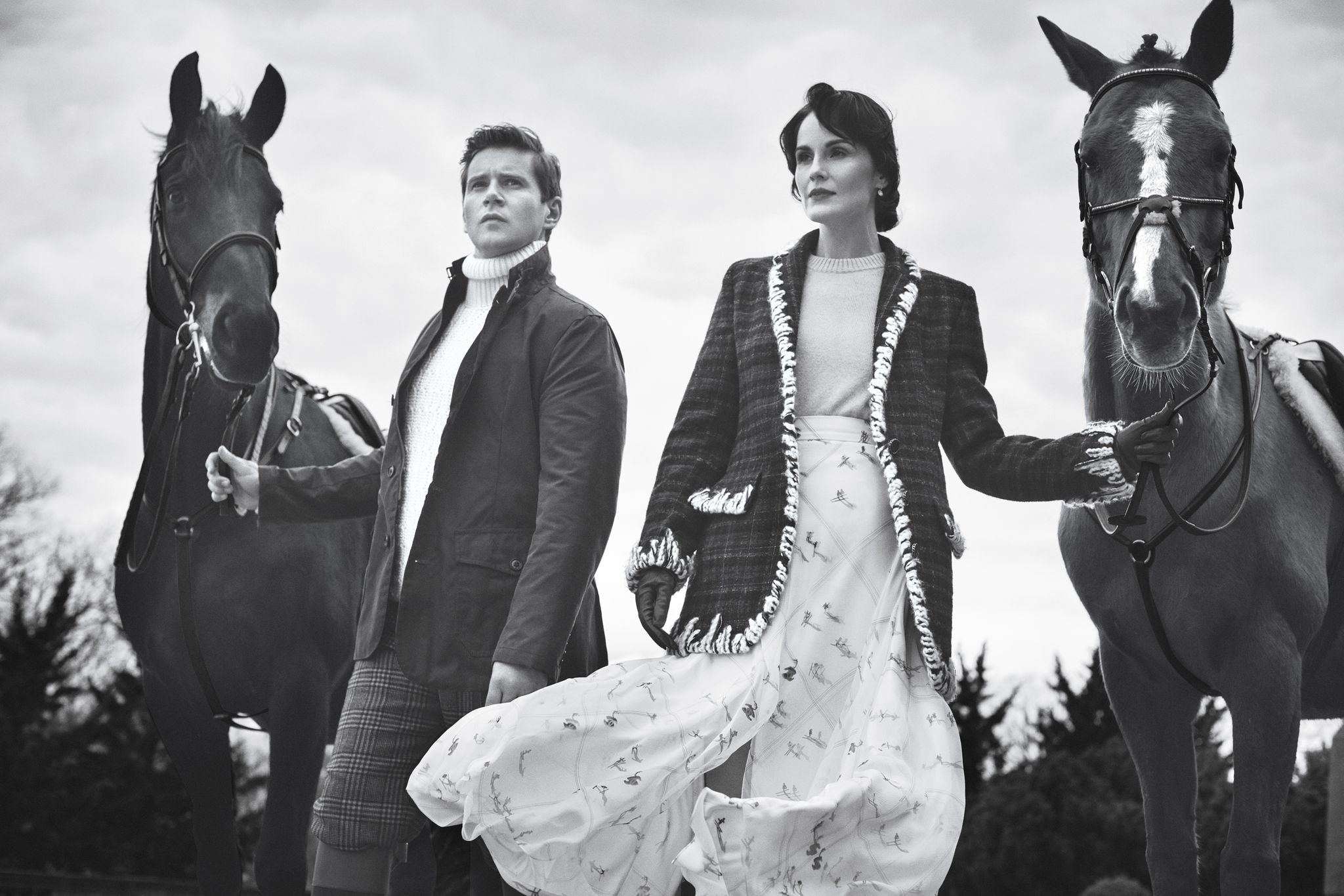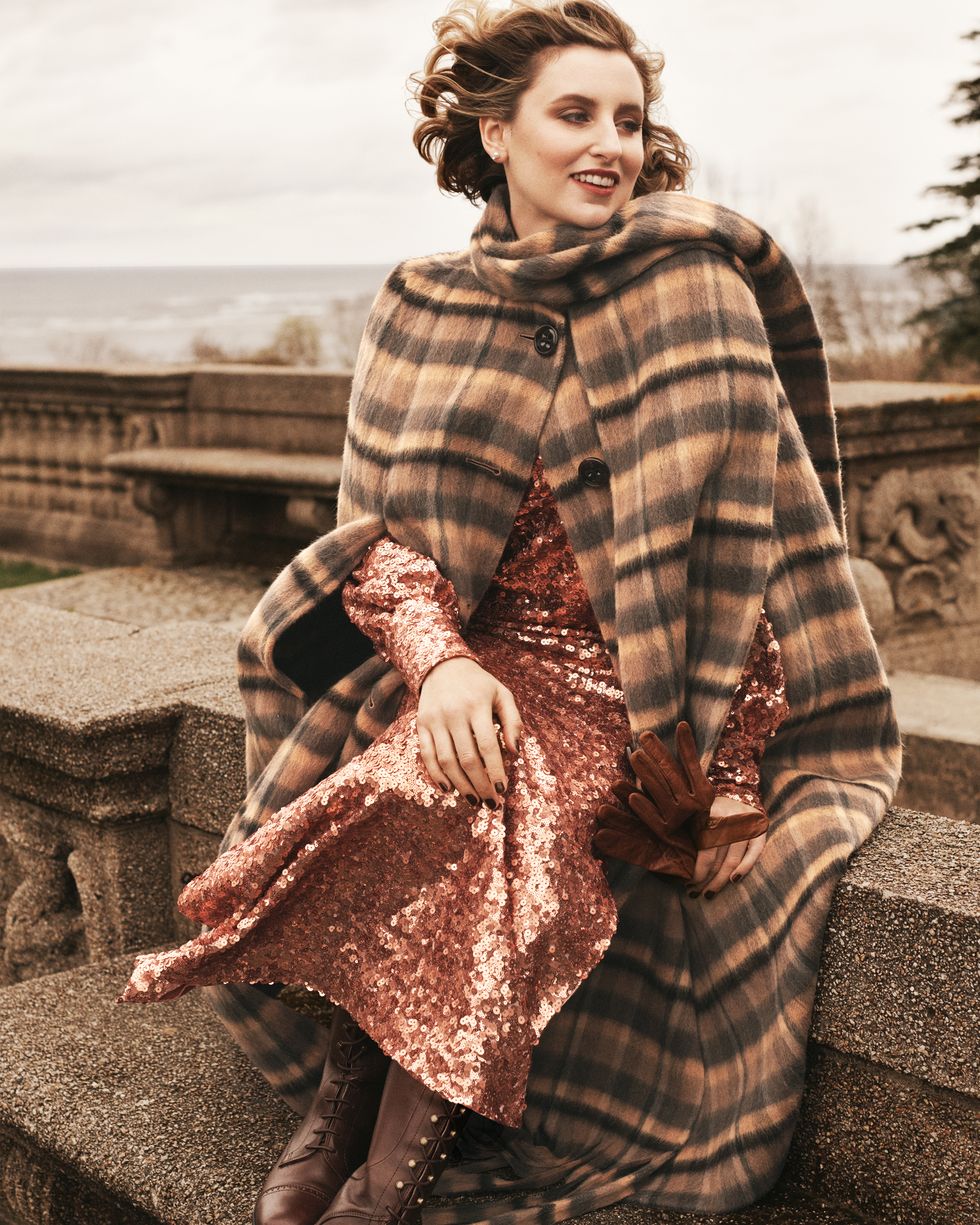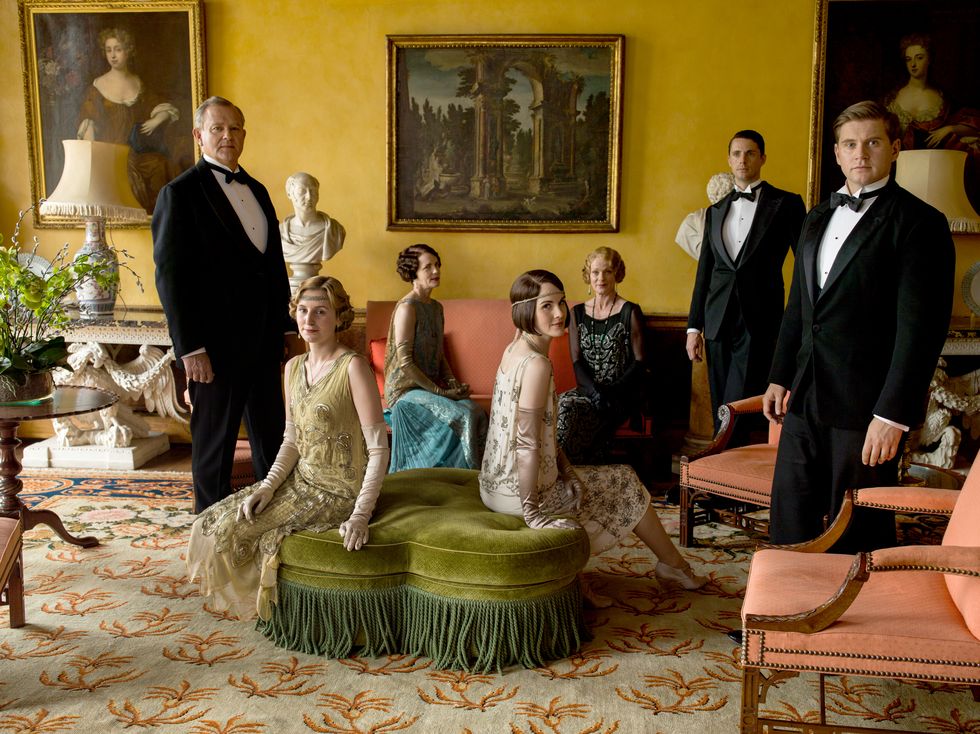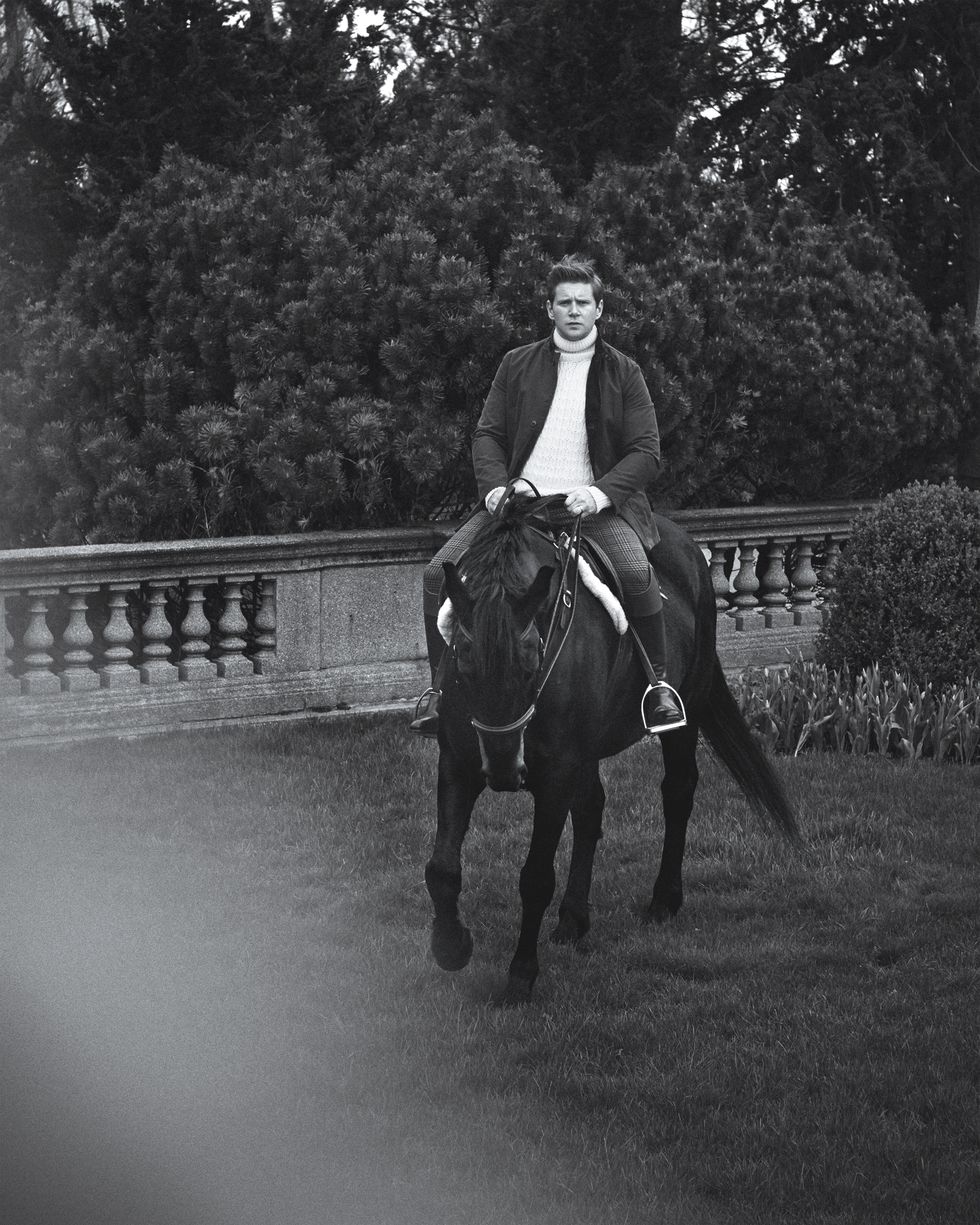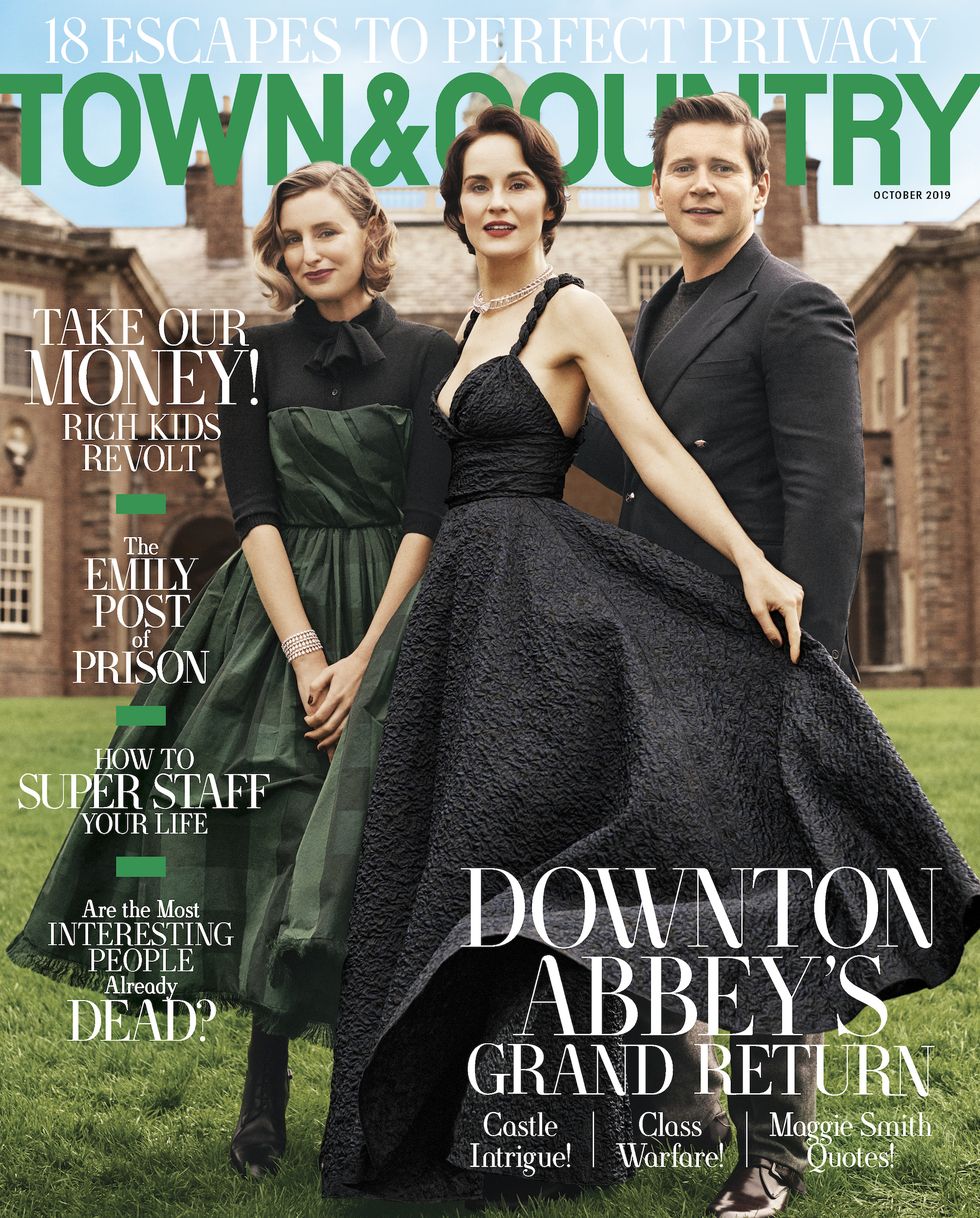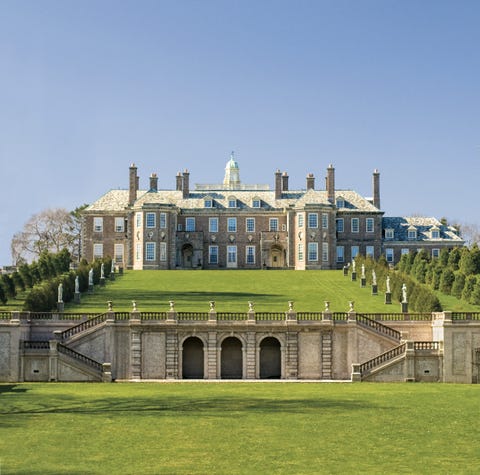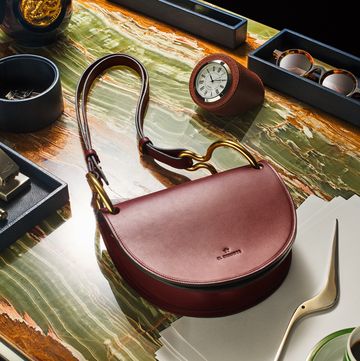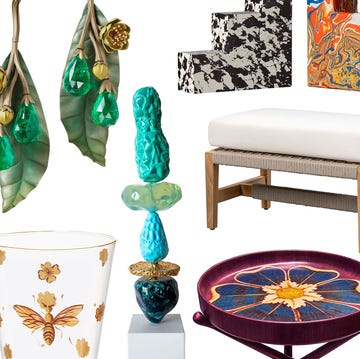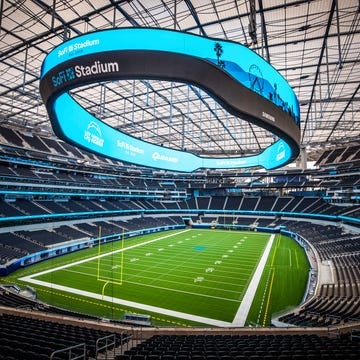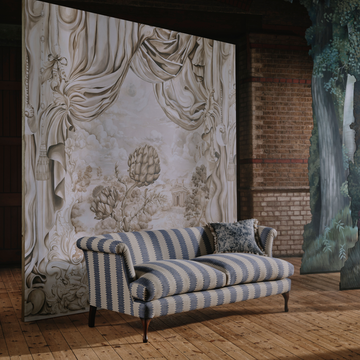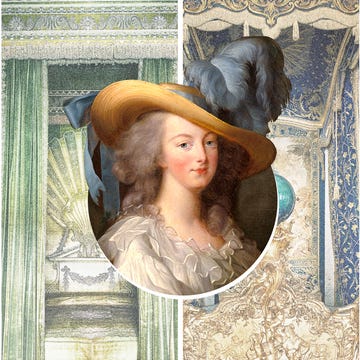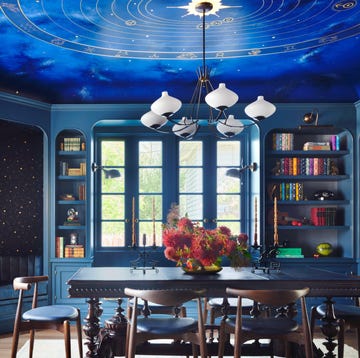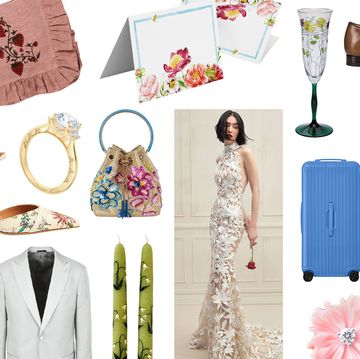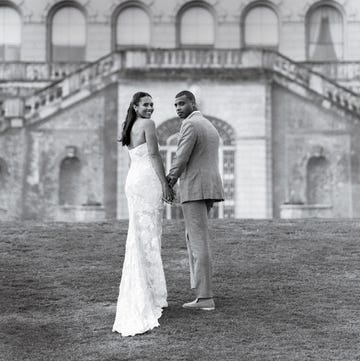It’s a moody, damp day in late spring, with clouds lingering overhead, as my chauffeur (okay, Lyft driver) drops me off on a gravel drive leading to a stone castle. Aside from the whinnying of a horse in the distance, the only sound comes from my feet crunching on the stones. I pause before opening the massive front door, half expecting a butler to do it for me. Inside, a maid clad in a black dress and ruffled white apron stands at the ready, while a pair of footmen flank an arched doorway.
This is not Downton Abbey, the fictional home of the also fictional Crawley family, nor is it Highclere Castle, the picture-perfect British estate that for six seasons served as the backdrop to the blockbuster period drama Downton Abbey. Rather, it is Castle Hill on the Crane Estate, about an hour outside Boston, where three of the series’s stars have gathered for a photo shoot to promote the feature-length Downton Abbey film, which comes out later this month.
The setting, a seaside mansion built in 1928 for a Chicago industrialist, is a glorious stand-in for the real deal, with its rolling green lawns and impressive stonework. Add to that the uniformed employees, and I am transported back to England in the 1920s, to the fanciful world of the Crawley family and the staff that served them (even if the employees at the Crane Estate get to clock out at the end of every day).
Which is why I’m having a hard time remembering to call the assembled trio of actors by their real names—Michelle Dockery, Laura Carmichael, and Allen Leech—and not those of the characters we’ve all come to admire: Lady Mary, the haughty eldest daughter of Lord Crawley; Lady Edith, Mary’s sister and bête noire; and Tom Branson, a former chauffeur who married up, joining the family as the husband to the third sister, Lady Sybil Crawley.
Today the women have traded their vintage beaded dresses for gowns by Dior and Hermès, but with their hair in finger waves and their necks adorned with jewels, they look remarkably like extra-glam versions of their onscreen personas. As I eavesdrop on their small talk, they even sound like them.
“About 17 hands,” Dockery says, as confidently and precisely as her Downton character, estimating the height of the stallion on which Leech is perched. I can’t help raising my eyebrows. Is this really happening? I want to shout my delight, but that wouldn’t be very Crawley-like, would it? It is surreal for a superfan like me to feel as though she has returned to the world of Downton, the first season of which was set more than a century ago—especially now, three years after the series ended.
Devotees mourned the loss of the weekly escape away from texting and tweeting, losing ourselves in a show that reminded us of the finer points of aristocratic hierarchy. We were whisked from glamorous dinner parties upstairs at the Abbey to cramped servants’ rooms downstairs and under the eaves, and across the English countryside on horseback hunts and steam train jaunts.
Downton’s pace was slow, its dialogue sparse, and its plotlines often based on the smallest moments, such as when Lady Mary scoffs at the idea of marrying one suitor because of the improper way he holds his knife. The show felt delightfully foreign and yet utterly familiar; series mastermind Julian Fellowes modeled Downton on American dramas with large ensemble casts, such as ER, crafting stories with ageless themes of life and death, love and fortune.
It’s no wonder, then, that for so many Americans, Downton—set in a time and place when daily routines and duties were entirely different from today’s plugged-in lives—was very much an escape. “A lot of very successful shows from this time period—Homeland, Breaking Bad—plunged you into contemporary concerns,” says Daniel D’Addario, the television critic for Variety. Downton teleported viewers back to simpler times filled with “amiable, friendly misunderstandings or petty grievances. It’s presenting a vision of the past as a time with challenges that were softer and more easily overcome than those of our own time.”
Though it wasn’t without its controversies. The scandals that punctuated Downton’s six seasons were also expected television fodder, from mysterious murders to torrid affairs. We cried at the untimely and tragic deaths and made memes out of Maggie Smith, the matriarch of the family, who had a penchant for delivering biting bons mots. Through it all, we joined the Crawley family and the servants in marking life’s milestones, and we agonized over the question of the Abbey’s viability—the universal question of relevance in the face of modernization.
Downton’s success, especially in the U.S., surprised those who made it. Americans obsessing over a period drama airing on PBS? It launched stateside in 2011, just before the TV landscape exploded beyond the standard network and cable lineups into a plethora of streaming options. “If it had been on one of the major networks,” Leech says—“or one you have to pay for,” Dockery interjects—“they would have pushed it too hard,” Leech continues. “Downton had to be discovered. It had to have that slow build.”
A tweet from Joan Rivers in February 2011, just a month after its U.S. premiere, was a turning point. The late comic wrote she was watching a “fantastic English drama,” to the delight of the cast. “Everyone went nuts, because we realized people were watching it,” Carmichael says.
This sleepy drama was a runaway hit, becoming the most watched show in PBS history. Downton garnered 69 Emmy nominations in its run, making it the most frequently nominated foreign show of all time. Michelle Obama, Beyoncé, and Queen Elizabeth are reportedly all fans. Salma Hayek allegedly said she would “kill for a role” on the series, Jamie Lee Curtis called herself “totally, maniacally obsessed,” and P. Diddy sent an angry letter to the show’s creators when a favorite character was killed off.
Former congressman Aaron Schock was said to have spent $40,000 redecorating his office with a Downton theme and later personally reimbursed the government for the expense. An exhibition of its costumes, set recreations, and props opened in Singapore and has been touring the U.S. since late 2017. In March 2016, 9.6 million Americans devoured the finale.
And that could have been that, a wildly successful run with a happy ending for the series, and many of its characters. Lady Edith, perennially unlucky in love, found a man with both a heart and a title; Lady Mary resolved to carry on the legacy of the estate. Downstairs, lady’s maid Anna and her valet husband Bates had a son, while head butler Carson stoically retired, clearing the way for Barrow to assume the top job.
The Downton actors toasted their fortunes and parted ways fondly. “We’d all said goodbye and had a great party at the Ivy—and away we went,” says Fellowes, who carries the titles of creator, writer, and executive producer. The idea of a movie had been floated but was far from a given—think of all the revered television series that haven’t turned into feature films. Yet the idea lingered. “It was as if people hadn’t quite been ready to say goodbye to the whole thing,” Fellowes says. “There is something rather extraordinary about the whole adventure.”
After six seasons the cast was a tad twitchy, and can you blame them? “I think after a time you start going, ‘Well, I do want to do other things,’” says Carmichael, who went on to British TV roles in Marcella and The Spanish Princess. Dockery earned an Emmy nomination for her turn in the miniseries Godless, while Leech appeared in the Oscar-nominated Bohemian Rhapsody.
A little break did the trick. Two years after the show wrapped, Dockery happened upon a TV special hosted by Leech that was appropriately titled I Miss Downton Abbey! “I watched the whole thing and I was sobbing,” she recalls. Her reaction was immediate: “Please, we’ve got to go back and do a film.”
As Dockery tells the story, she is sandwiched between Leech and Carmichael on a faded chaise longue at the castle outside Boston. After a long day of shooting, the three—who clearly enjoy each other’s company—huddle together for the duration of our interview. My questions prompt a kind of romantic reminiscing, which might seem saccharine if it weren’t so lovely.
“There was never a day when we didn’t have lunch together,” Carmichael says. The lack of ego from the established stars, including Maggie Smith and Penelope Wilton, set the tone for the younger members of the cast. On Leech’s first day everyone sat on the grass and asked him questions—a far cry from solo stints he had spent in his trailer on other jobs.
This camaraderie proved useful when it was time to make the movie. Michael Engler, who directed the film (as well as the series finale and four other episodes), praises the cast for its ability to be part of a company. Scenes with all hands on deck, like at a dinner party, can take a long time to shoot, leaving the biggest stars feeling like extras as they wait to deliver a line or two. Engler commends their collective ability to both focus and relax—and to be ready at the exact moment they’re needed. “I find it incredibly generous,” he says. (“We just love watching each other do their jobs,” Leech says.)
Even after Downton became a success, the vibe on the set remained unchanged. “When we came back to filming, it felt the same,” Dockery says. “It was like just going back to work, seeing your mates.” This is all a very long answer to the question: How did the producers convince so many of the principal actors to return for the film? It seems they love it as much as we do.
"It’s really special when you walk up that drive,” Dockery says of returning to film at Highclere Castle, an hour and a half outside of London. Fellowes says that when he arrived on the set of the film and saw the set and the costumes, it sparked a sensation like “finding Bobby in the shower,” referring to the infamous plot twist on Dallas in the ’80s. “The whole thing felt a bit like a dream.”
Downton the television show began with a journey like the one Dockery and Fellowes describe, up the path to the fictional Abbey. The movie opens in the same way. But this time, instead of the messenger approaching on a bicycle, he’s on a motorbike; the news he is delivering isn’t the death of two Crawley cousins on the Titanic but word that King George V and Queen Mary will be coming to stay.
The idea came to Fellowes while he was reading a book about a visit the real king and queen made to Wentworth Woodhouse, the largest private residence in the UK. “I wanted something that would affect both the family and the servants; they would all be drawn into this exciting event,” Fellowes says. “I thought a royal visit would rather answer that.” It also kept the action conveniently within the confines of the Abbey.
The challenge, for Fellowes and the film, was to pack a plethora of story lines into just two hours. Unlike the television series, which could have characters fade in and out, in the movie each must get his or her due between the opening and the end credits. That’s a tall order given that the Downton movie has 20 returning stars.
“You can’t say, ‘You have to wait until the next film to find out how that worked out,’” Fellowes says. “You’ve got to really get your jigsaw organized.” And then there is the issue of legacy. This show has been career-defining for all involved, and nobody wants to mess with that. “When we all get to the end of our careers, Downton will be one of the main things we did, and that’s a rather extraordinary feeling,” he says.
As if there weren’t enough established characters to revisit—Cora, Anna, Daisy—the movie includes a handful of newcomers. Imelda Staunton enters as the queen’s lady-in-waiting and a distant relative of the Crawleys. She is also the real-life wife of Jim Carter, who plays Mr. Carson. But because Staunton was part of the upstairs cast, and Carson remains mostly downstairs, their paths crossed on only three days of shooting. “I saw her across a crowded dinner table and in a field full of horses,” Carter says. (Not relevant but worth sharing: Over the phone Carter is indistinguishable from Carson, both in voice and interests. Since filming wrapped, he says he’s been spending a lot of time tending his rose garden.)
Overall, the movie feels like an elaborate episode of Downton. The royal visit provides plenty of drama and pageantry, as well as a natural narrative arc with tensions surrounding the preparations for the king and queen’s stay, their arrival, and the duration of the visit. The film moves at a pace dictated by the sheer number of subplots. Lady Edith returns triumphant as the highest-ranking member of the Crawley family, while Tom becomes a pivotal part of some of the biggest twists. And ready your hankie for a moment between Lady Mary and the Dowager Countess that—no spoilers—shows off a softer side to the tough-as-nails matriarch.
The scenes themselves feel grander on the big screen, but nothing in the script feels out of place. When friends ask Carmichael not to ruin the ending for them, she shrugs and says in a voice reminiscent of Edith’s, “I wouldn’t know what to tell you.”
For his part, Fellowes has an extremely British goal for the movie. “I hope we are undisappointing,” he says.
He has certainly achieved that, and much more. It’s a treat to return, albeit for just two hours, to a world I thought was long gone. When the lights went down my heart swelled in a kind of Pavlovian response to the theme music. It’s thrilling to be back with characters who feel like family; the glamour of the royal visit only adds to the enchanting homecoming. I rejoiced at seeing Carson putter around his garden, and my eyes danced along with Branson during his soaring sunset waltz.
Back outside Boston, as the sun begins to sink, Dockery, Carmichael, and Leech emerge from the basement clad in their street clothes—reminding me once again that they are human. With a black SUV idling in the background, Leech pops a celebratory bottle of champagne. A giddy, goofy toast commences. I hang back, sad to be saying goodbye to Downton once again.
But is this the end? The final shot of the movie, at least in the cut I saw, lays the groundwork quite nicely for a sequel. For the record, Fellowes is on board. He says, “I certainly wouldn’t refuse.”
Photographs by Tom Schirmacher; Styled by Anne Christensen
Hair by Thom Priano for R+CO Haircare. Makeup by Rachel Goodwin at Streeters for Koh Gen Do. Manicure by Hanh Phan at Ennis Inc. Tailoring by Karon Yee and Bettina Hastie at Ennis Inc. Horses Courtesy of Equine Rescue Network. Production Services by Karen Stark at Right Coast Locations. Special thanks to the Trustees of Reservations for this location.
It may not be Highclere Castle (the filming location of Downton Abbey), but Castle Hill on the Crane Estate in Ipswich, Massachusetts, served as a worthy backdrop for this story. The sumptuously furnished 59-room mansion sits on 165 acres of manicured grounds and is now open to the public. T&C paid a visit to Castle Hill back in 1935, when it was the summer home of Chicago industrialist Richard Crane and his wife Florence. Crane had bought the property in 1910 and built an Italian Renaissance–style villa. Florence hated it, so he replaced it with the current building. We christened it “a great American house.”Courtesy of The Trustees of Reservations.
This story appears in the October 2019 issue of Town & Country. SUBSCRIBE NOW

Elizabeth Holmes is a New York Times bestselling author of HRH: So Many Thoughts on Royal Style, an exploration of the power of fashion inspired by her popular Instagram series. A veteran multimedia reporter, Elizabeth spent a decade on staff at the Wall Street Journal. She is a contributing editor at Town & Country; her work has also appeared in a host of other outlets, including the New York Times, the Financial Times, and Elle. She lives in Los Angeles with her husband and three young children.
